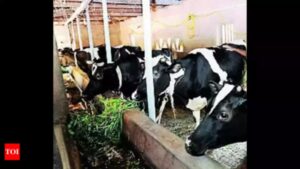
Milk, with its high-quality proteins, fiber, and minimal fat content, serves as an instant energy source for the body. It plays a vital role in maintaining good health and achieving life goals by promoting muscle development and combating weakness. Furthermore, mother’s milk is essential for the health and well-being of children. In an era where people are increasingly focused on physical fitness through various exercises and yoga, as well as the consumption of weight-gaining supplements with potential side effects, it is crucial to raise awareness about the numerous benefits of milk consumption.
In today’s world, the prevalence of unhealthy junk food consumption poses a significant risk to our well-being. Milk, however, is a nutritional powerhouse, containing essential nutrients that contribute to overall health and fitness. The versatility of milk allows for the production of a wide range of dairy products.
While India leads the world in milk production, the production in Jammu and Kashmir remains relatively low. Livestock farming has emerged as a vital sector in the Union Territory of Jammu and Kashmir, significantly contributing to its socio-economic development. Approximately 80% of the population in Jammu and Kashmir resides in rural areas, and agriculture and animal husbandry account for about 60% of the state’s revenue. Dairy farming holds the potential to provide additional income to rural residents, contributing significantly to the national income and serving as an insurance against crop failures.
Despite its potential, the productivity of milk in the hilly regions of Jammu and Kashmir is limited due to challenges such as the region’s diverse climates and small land holdings. The lack of modern farming technologies in small farms hinders fodder production. To address these issues, the Department of Animal Husbandry in J&K and SKUAST-Jammu and Kashmir are offering technological guidance to farmers and providing frozen semen from pedigree bulls to veterinary dispensaries.
India boasts a diverse array of animals and is the largest cattle producer globally. However, buffalo production in J&K lags behind the national average. Implementing buffalo breeding programs, promoting crossbreeding, and introducing Jersey bulls can significantly improve the cattle breed in J&K. Furthermore, advanced breeding tools and clinical animal health services should be emphasized to enhance animal health and productivity.
Balanced animal diets are essential for optimal production, reproduction, and animal health. Addressing the deficit in fodder availability, particularly during the offseason, is crucial for dairy farmers in J&K. Scientific techniques for hay and silage making, as well as training on fodder cultivation, should be provided. Researchers can play a role in developing cost-effective and nutritious cattle feed from agricultural products.
Infrastructure development, especially in hilly areas, is necessary for dairy plant expansion and increased milk collection. Bulk coolers and refrigeration systems, along with organized rural markets, can foster rural development. Small dairy farmers, who face challenges such as limited access to nutritious feed, timely credit, and quality veterinary care, should be a primary focus. Providing institutional credit and superior breeds of animals to rural areas can further bolster dairy farming.
Effective collaboration between scientists, extension workers, and dairy farmers is essential for tailoring livestock production technologies to the socio-economic and agroecological conditions of the region. By nurturing the dairy sector in Jammu and Kashmir, we not only support the livelihoods of dairy farmers but also ensure the availability of this essential source of nutrition in various forms. Let us extend our gratitude to the dedicated dairy farmers who bring us the goodness of milk.





